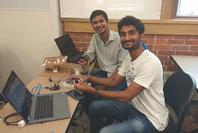Grad students create robotics projects
Teams presented their projects to Martinez at the end of the spring semester. Some of this semester's projects included new wearable devices, biomedical tools, autonomous vehicles, and interactive toys.
"In this course, students learn how to automate tools, control robots using wireless communication, and build their own prototypes using rapid prototyping tools like laser cutting," said Martinez.
"The goal of the final projects of this course is to get the students to think about a need in our current technology, and design and develop a prototype that can be directly applied to meet that need," he explained. All of the projects had to meet three requirements:
- SENSING: The devices need to be aware of their surroundings and provide help or information when needed.
- AUTONOMY: All the devices need to communicate with the user using wireless communication.
-
INCLUSION: The devices need to be easy to hide as a wearable device or a small enough to provide useful information to the user without interfering in daily life.
Master's students Rahulkumar Baranwal and Brijesh Poojary created a motion-controlled wireless labyrinth puzzle. The structure is a labyrinth maze and has a movable base controlled by servo motors. The operator wears a strap with an accelerometer to measure the twist of a hand. The data is then coded and sent wirelessly to the receiver which controls the servo motors, which were carefully calibrated to maintain horizontal stability.
"This project demonstrates that traditional systems can be converted into wireless motion-control systems for very low cost using basic sensors," said Baranwal. "We started this course with a very basic knowledge of electronics, and in a semester we managed to apply our learning to this fancy project. We [were able to] make the motion more smooth and also implement a few more aspects to the game like a timer and different difficulty levels."
"Many of the students taking this course did not have previous experience in circuit design or programming microcontrollers," said Martinez. "However, thanks to their efforts during the course, they were able to invent new robotic devices using servo motors, a variety of sensors, and complex wireless communication algorithms."
"I am very glad to see how, using their imagination and the concepts learn during the course, our students developed new products with the idea of helping people and expanding current technological limitations," he concluded.
(Video provided by R. Baranwal)
Writer: DeEtte Starr, starrd@purdue.edu

